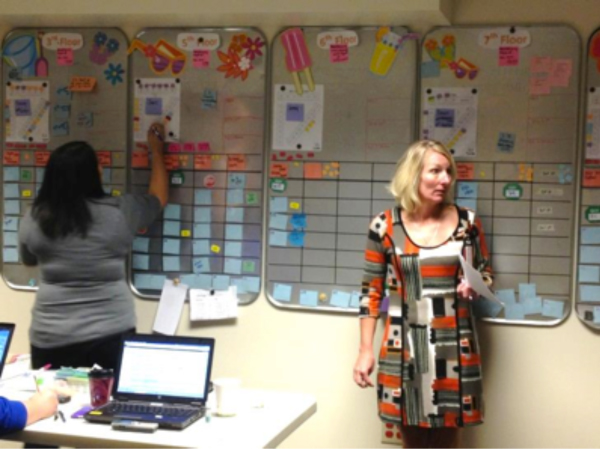As a former healthcare employee at North Shore Medical Center, I’ve always wanted to visit ThedaCare. In my previous job, I remember reading articles, seeing video clips, and hearing wonderful things about the ThedaCare healthcare system. As an LEI employee, many of my colleagues said it was one of the best examples of TPS they had ever seen.
When I finally got a chance to go to ThedaCare (Appleton Medical Center in Appleton, Wisconsin) in September, my visit did not disappoint.
Across the board, just as they preach, ThedaCare is patient-centered. Lori (the patient) is a word that’s heard and seen all over the hospital. Lori is their patient and their true north. She has a face and a name and is a real person. On each floor, on each board there is a picture of Lori. Every project, mission, and objective actually connects back to Lori. Lori is why ThedaCare wants to build healthy communities.
More than this, ThedaCare does an outstanding job of developing people (as we like to say at LEI). As former CEO John Toussaint guided a group of healthcare CEOs and senior leaders through the hospital’s hoshin room and corridors of the hospital, we were soon greeted by Julie, a Nurse Manager in one of the cardiovascular inpatient units. “I’m constantly thinking about developing my staff. Who’s my next educator? Who’s my next team lead?”
Like patients, team members need to progress, too. The nursing staff consists of a Registered Nurse and a Licensed Practical Nurse (LPN) for every six patients. LPNs are used to the maximum of their credentialing, being able to push IV medications, for example, amongst other abilities. Most newly hired nurses are hired not to a floor, but to the Learning Center, a clinical lab for testing hypotheses and a different way to bring people up to the standard of collaborative care. Though real patients are not used there, students and new hires take turns being the patient, which helps them develop empathy.
When our group of industrial tourists went to the collaborative care based cardiac floor, I was amazed. Though the visual controls such as the kamishibai boards were well made and certainly useful to staff, what was most striking to me was just the calmness and tranquility of the floor. I don’t know about you, but when I think of cardiovascular floors, I think of monitors, loud alarms, and lengthy printouts of cardiac rhythms spilling out onto the floor. Not here. On a full 24 bed unit in the middle of the day at Appleton Medical Center, all you see is calm staff, a clean and hazard free hallway, and a few visuals outside of each patient room to cue others as to the needs of the patient.
 |
Additionally, one of the units is piloting a production control room. Discharges have a 60 minute time standard, which is how production control plans for patient allocation. But before building an electronic information system, a team is assembled to pilot how information should flow in and out of the ideal board. As you can see from the photo, there are colored post-its, stickers, and other visual cues representing the work with someone moving the pieces as the work changes. This is pretty incredible. Not jumping right to a solution is a hard practice, but here we were watching people in real-time “act their way into a new way of thinking.”
Finally, to keep communication flowing and inspire PDCA thinking, clinical and support teams gather in a large centrally located conference room on Fridays with zealous visitors and fellow ThedaCare employees to learn more about the current problem-solving activities underway.
One of my favorite moments was when a cardiologist took the stage. He openly confessed how inundated he initially felt with so many new lean words; terms like “takt time” and “cycle time” were foreign to him. But then, with great pride (and humor), he shared with a room of 300 people, “Finally, our lean guy talks to me about the pace of the work, the pacemaker, and I say to him, now THAT I know!”
Seeing organizations like ThedaCare and meeting people like these is what makes this Lean work worth it. ThedaCare staff all come to work looking to better the health of and experience for Lori. Without a doubt, continuous improvement is hard. But ThedaCare is a great example of how it can also be fun. My trip to ThedaCare was another good reminder that Lean not only applies to all industries, but how capability development and continuous improvement go hand in hand.
Editor’s Note: Check out ThedaCare in TIME Magazine in the “The Real Face of Healthcare Reform,” by Rick Wartzman of The Drucker Institute.





